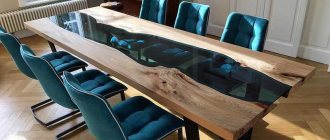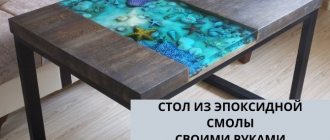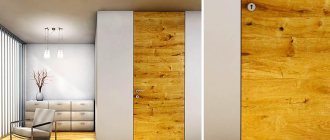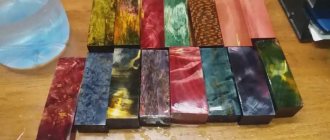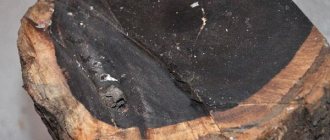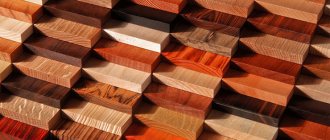Artistic creativity using epoxy resin has formed its own direction in design art. Today, this unique material is no longer associated with the epoxy that filled the building materials markets back in Soviet times. The scope of its application has expanded significantly due to the emergence of various modifications of the polymer.
Modern manufacturers offer various resins for pouring floor coverings, making furniture, jewelry and decorative items. We can say that the resin has not lost its original properties, but thanks to the addition of various additives and the use of modern production technologies, it has expanded the list of important qualities.
The use of decorative elements in epoxy products has made it possible to significantly diversify the direction, and the high adhesion of the resin practically removes all restrictions on the use of decorative materials. But the tree was and remains a classic, not losing its relevance in almost all styles, from romance to boho. Wood has a number of advantages over other materials, so products made from epoxy resin and wood form the basis of a relatively new movement associated with creativity.
- Wood suits any interior style.
- The natural texture serves as a ready-made decor for products made from transparent resin.
- The material is accessible.
- Wood is easy to process.
Combinations of resin and wood produce original masterpieces, no matter in what field of activity they are used. When creating furniture, slabs simultaneously play the role of a base and perform a decorative function. In decorations or souvenirs, wood can be found in different forms: saw cuts, slices, solids, shavings. In any presentation, this natural component decorates the craft, giving it a unique lively flavor.
Selection of material
In order for a particular material to be freely used when pouring products, it is necessary that the epoxy has good adhesion to this material. In simple words, they must “stick together” well. Otherwise, peeling may occur inside the polymer, which will negatively affect the appearance of the product. In this regard, wood combines well with resin, but several nuances of pouring must be taken into account.
Epoxy resin for wood is not a type of material. The brand of resin is selected depending on the product and its scope of application.
To fill floors, you need to focus on the strength indicator. For the manufacture of tabletops, the fluidity of the compound is important, and decorations and souvenirs are excellent from transparent resin. The epoxy composition is easy to prepare at home. The resin is usually sold as two components in a kit. The base composition may be called component “A”, and the hardener may be called component “B”. When they are mixed, a chemical reaction occurs. As a result of polymerization, a substance is formed that retains its shape and volume.
The reaction of interaction of oligomers with the hardener occurs with the release of heat. An intense reaction can cause the resin to become overheated and even boil. To avoid this, you should not work with large volumes if you do not have the skill to handle materials. The larger the volume, the more energy is released as a result of the reaction.
Another parameter on which the intensity of interaction of reagents depends is the lifetime of the resin. Many people try to choose resins that have a minimum lifetime. They motivate their choice by the fact that in this way they can reduce the hardening time of the compound, but this is a mistaken opinion.
Useful to know > Epoxy resin table - a modern solution for an excellent interior
- Firstly, the time for complete cure is independent of the pot life.
- Secondly, the long lifetime corresponds to a less intense reaction, therefore eliminating overheating of the resin.
When stirring, many air bubbles appear in the resin. If they do not come to the surface, they will remain in the frozen compound and spoil the whole picture. Experienced professionals can remove bubbles, but it is recommended that all possible measures be taken to reduce their number.
For example, the components must be mixed carefully so that new bubbles do not form. For complete mixing, it is recommended to pour the resin from one container to another. It is necessary to pour in a thin stream, since at this stage there is also a high probability of bubbles forming.
If appropriate equipment is available, vacuuming is used. By lowering the air pressure above the resin, an accelerated release of bubbles from the resin is achieved. The remaining bubbles are dealt with after pouring by heating the epoxy with a hairdryer.
Basics of safe work
Although the name of the substance contains the word “resin,” it contains no natural components. If you come into contact with epoxy, there is a danger of being harmed by the fumes released. Therefore, it is necessary to observe safety precautions:
- work with gloves;
- wear a respirator to prevent inhalation of vapors;
- arrange ventilation in the room;
- limit access of household members to the place where the work process takes place, especially children and animals;
- do not be distracted while working.
In order not to spoil the surface of the table, you need to place a special board or film.
Filling Features
In any of its manifestations, wood is well bonded with epoxy resin, but this does not eliminate some problems. Most of these problems are global in nature, so there is no need to provide specific examples of work algorithms. Let us highlight the general nuances that every master should take into account.
A slab or solid wood simultaneously plays the role of a base and decoration. It must be remembered that the density of wood is less than the density of resin, so when pouring in one layer, wooden fragments may begin to float. In order to avoid calculating the buoyancy force, it is easier to prevent this phenomenon. To do this, pour the first layer of resin, about 1-1.5 mm thick, which will act as an adhesive composition. Decorative fragments are glued to the resin. After the resin has completely hardened, you can continue pouring.
When pouring countertops, several fragments of solid wood are used, which are located at different levels. Thus, a kind of three-dimensional picture is formed. When pouring layer-by-layer, there are usually no problems. If it was decided to pour the resin in one layer, then these fragments are fastened together by any available means.
It is quite a big problem to pour a piece of wood into a lens or sphere when making jewelry; it will definitely float up. There are several ways here. The first is to first pour a layer of epoxy resin to the level where you want the decorative element to be located. You can safely let it float and wait for the resin to cure. Then the remaining compound is poured. The second way is to hold a piece of wood with a thin wire.
All wood has pores. When liquid resin begins to fill them, air comes out of the pores. Even if the composition has undergone a vacuum procedure, this will not eliminate the formation of bubbles. The way out of this situation is pre-impregnation. Wooden elements must be coated with colorless primer. In the absence of a special composition, you can use the same resin from which the product will be made. Filling should begin only after the soil has completely hardened or the impregnating layer of resin has cured.
Using wood with epoxy resin as the main material, it is necessary to pay due attention to the preparatory process. After processing wood, dust and small sawdust accumulate on its surface and in various pores. If they are not removed, they will float in the resin, forming suspensions. This nuance once again confirms the need for preliminary priming. Even if all particles could not be removed, they will be retained by a layer of primer.
Useful to know > What are the types of decorations made of wood and epoxy resin?
Filling table
Such furniture production is considered labor-intensive. The basis is thick glass and a piece of plywood in the shape of the desired table.
Lightweight parts of the design are glued to prevent them from floating up. It is necessary to make a side so that the mixture does not spread. The side is nailed with small nails.
Before pouring, check that the base is dry. The tree is covered with a soil mixture; a layer no thicker than 1 centimeter can be poured at a time.
If there are large parts, they are poured in several stages. This product can be put into operation within a week.
After this time, it will be sanded and polished again from the beginning, if necessary. It is also recommended to varnish such products to avoid defects.
Tabletops
Tabletops made of wood and epoxy resin are quite practical, so they have long gone beyond the boundaries of interior items. They are used not only in residential buildings or apartments, but also in office and industrial premises. The absence of copies, even with the same technology, allows us to speak about the uniqueness of each product.
The use of wood opens up wide possibilities for the designer. All models of countertops can be divided into several types, depending on the method of using wood.
- Table tops with slabs at the base. A longitudinal section of a tree trunk plays the role of a base onto which transparent resin is poured. The advantage of this method is that there is no need to decorate the product, since the wood has a specific and unusual pattern. In addition, the structure is quite durable and can withstand heavy loads.
- Table tops with slabs as decoration. If the cut area is far from the area of the future countertop, then the slab is unlikely to become the basis for the structure. However, the poured slab is still durable. In order to save material, appropriately sized saw cuts are laid on the bottom layer of the tabletop. An interesting option is to imitate a world map. The slabs are processed so that they are shaped like continents. Blue-tinted resin is poured into the space between them to imitate the oceans. If you add a phosphor to the resin, the table will be illuminated in the dark.
- Table-river. A fairly common type of product, made of two slabs located at a distance from each other. The space between them is filled with resin. An image of a river is created, in which the wood is visually similar to the banks.
- Array. Finally, a separate category is represented by countertops, the volume of which consists almost entirely of solid wood. The resin is poured into crevices, artificial cracks, wormholes and aligns the boundaries of the slab along the perimeter. The result exceeds all expectations, and it is also possible to save on resin, since its consumption is low.
What is epoxy resin?
Epoxy resin is a two-component thermosetting liquid polymer.
But, avoiding chemical terms that are incomprehensible to novice craftsmen, we can say that epoxy resin is a product consisting of two liquid components A and B (where “A” is a resin and “B” is a hardener), mixing which in certain proportions starts hardening process with heat release.
Epoxy resin for jewelry
As a result, liquid resin poured into silicone molds, formworks, or on top of blanks turns into hard plastic-like decorations, paintings, trays, coasters, and even tabletops.
Furniture
The table is an integral part of the kitchen set, so it should be classified as furniture. But we preferred to consider it as a separate topic, since it was with the production of countertops that experiments with resin began. It should be noted that the variety of table models somewhat prevails over other furniture.
You can make bookshelves from wood and epoxy. It is not advisable to make shelves in a closet from epoxy, since they will be hidden from view, but for a wall-mounted shelf such options are quite acceptable. All techniques used in the manufacture of countertops can be applied here. But wood in any form is considered a mandatory attribute.
If you fill a shelf with just resin, it can break under the weight of the load, and the wood acts as an element to increase strength.
Doors made of epoxy resin serve as an unusual decoration for the interior of the room. The most popular and practical design is obtained using 2-3 slabs, which are filled with resin. To make a door, you need to select a flat horizontal surface and make formwork. It is important to understand that the slightest deviation will ruin the product. It is also necessary to provide for the force experienced by the door suspension points. It is advisable to reinforce the hinge attachment points with wooden beams. Otherwise, the decorating and filling techniques are the same as described above.
Useful to know > What epoxy resin backlit tables look like, what they are like and how they are made
In a kitchen set, the shield connecting the upper and lower tier is called an apron. It is usually made of plywood and covered with laminate. If such an apron is filled with resin, you will get a very beautiful and harmonious design, and epoxy table covers will only bring this design to perfection. It would be appropriate to add a phosphor to the resin or create electric lighting. Indeed, the space under the upper tier cabinets suffers from a lack of lighting. Illuminating an apron can become not only a decoration, but also a practical device.
Under what conditions can you work with epoxy resin?
Work with resin should be carried out in a well-ventilated/ventilated area (away from kitchens and living rooms) with (important!) low humidity at a temperature not lower than 20 and not higher than 25-27 ° C. The resin is very afraid of moisture, so it should not be in the molds/blanks, otherwise cloudy stains and other defects may appear on the surface of the product after hardening. Therefore, it is also not recommended to work with resin during or after rain or near bodies of water.
Art Pro 2.0 epoxy resin , which has good moisture protection.
Jewelry and souvenirs
The specificity of wood blanks does not allow them to be used for decorating epoxy bracelets and rings. The exception is small wooden products, but these are very rare. But in the manufacture of pendants, pendants and souvenirs, wood is both a decor, a connecting element, and a filler. Wood is used in any form, from plywood to cross-cut. The work of a craftsman involves the need for complex woodworking tools. Gradually, a hobby develops into a profession. Those craftsmen who share their experience on the Internet have been working with resin professionally for a long time, and their products are in demand.
To prepare a cross cut, it is best to take not a trunk, but a tree branch. The pattern will also be visible on this cut. To highlight it, the surface is treated with stain. The difficulty lies in cutting an element of a suitable shape and size from the workpiece. After priming comes pouring. The resulting pendant doesn’t even require any special fittings. A hole for a cord is drilled in it and you get a beautiful souvenir.
There are many ideas for creating jewelry from longitudinal cuts.
The shape of the product depends on the existing mold. Most often, keychains are made from epoxy and wood. The unique properties of the resin allow it to be processed after curing. By grinding, the thickness of the product is reduced, turning it into a pendant that can be worn on the body.
